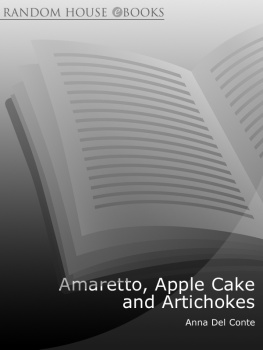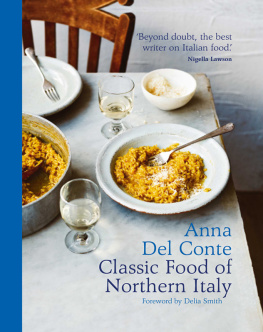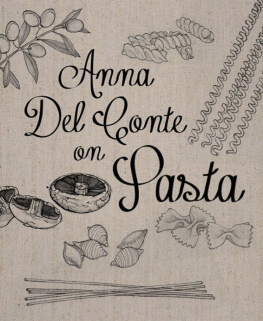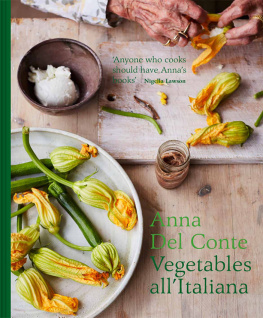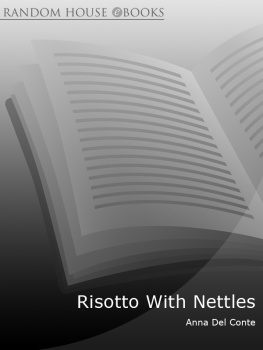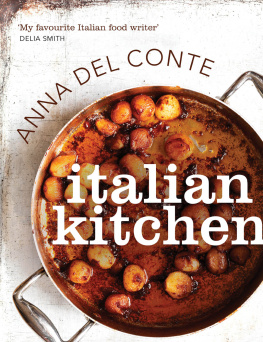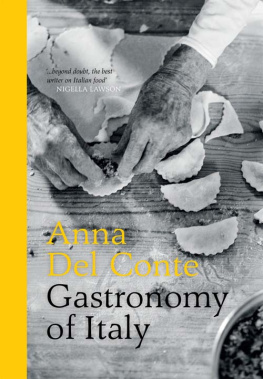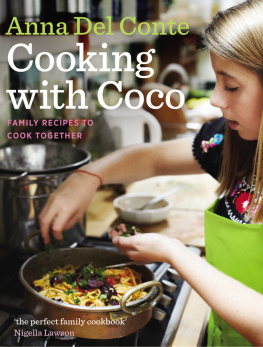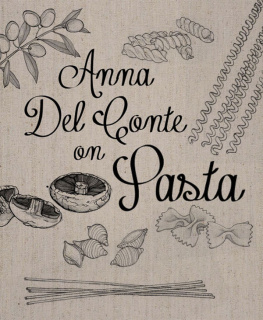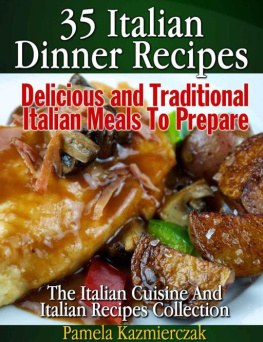This ebook is copyright material and must not be copied, reproduced, transferred, distributed, leased, licensed or publicly performed or used in any way except as specifically permitted in writing by the publishers, as allowed under the terms and conditions under which it was purchased or as strictly permitted by applicable copyright law. Any unauthorised distribution or use of this text may be a direct infringement of the authors and publishers rights and those responsible may be liable in law accordingly.
Version 1.0
Epub ISBN 9781448138418
www.randomhouse.co.uk
Published by Vintage 2006
2 4 6 8 10 9 7 5 3 1
Copyright Anna Del Conte 1989, 1991, 2006
Anna Del Conte has asserted her right under the Copyright, Designs and Patents Act 1988 to be identified as the author of this work
This book is sold subject to the condition that it shall not, by way of trade or otherwise, be lent, resold, hired out, or otherwise circulated without the publishers prior consent in any form of binding or cover other than that in which it is published and without a similar condition including this condition being imposed on the subsequent purchaser
These recipes were previously published in Secrets from an Italian Kitchen in 1989 and Entertaining AllItaliana in 1991 by Bantam Press
Vintage
Random House, 20 Vauxhall Bridge Road,
London SW1V 2SA
Random House Australia (Pty) Limited
20 Alfred Street, Milsons Point, Sydney,
New South Wales 2061, Australia
Random House New Zealand Limited
18 Poland Road, Glenfield,
Auckland 10, New Zealand
Random House (Pty) Limited
Isle of Houghton, Corner of Boundary Road & Carse OGowrie,
Houghton, 2198, South Africa
The Random House Group Limited Reg. No. 954009
www.randomhouse.co.uk/vintage
A CIP catalogue record for this book is available from the British Library
Line drawings by Elizabeth Carpenter
ISBN 9780099494164 (from Jan 2007)
ISBN 0099494167
www.vintage-books.co.uk
contents
about the book
In this book Anna Del Conte has collected together the best of her delicious recipes along with tips, anecdotes and reminiscences about her life in Italy and London. Packed with inspiring information from the best way to make a tomato sauce and a tiramisu to more unusual dishes such as nettle risotto and chestnut mousse, each chapter is devoted to a different ingredient.
As well as explaining the basics and introducing more surprising recipes, Anna includes special additional chapters describing traditional regional and historical menus. So whether you want to eat tagliatelle with ham and peas or rabbit with rosemary and tomato, a Roman Late Supper or a Renaissance Dinner, you will find what you need here.
about the author
Anna Del Conte was born in Milan and lived there until 1943, when she and her family evacuated to Emilia Romagna. She read History and Philosophy at Milan University but left in 1949 to learn English in London, where she also met her husband.
In 1975 her first book, Portrait of Pasta, was published. After the acclaim the book received she became the first cookery writer in England to specialise in Italian food. Her books have won many prizes: Gastronomy of Italy received the Duchessa Maria Luigia di Parma award, Entertaining AllItaliana was shortlisted for the Andre Simon Award, The Classic Food of Northern Italy won awards from the Guild of Food Writers and from the Accademia Italiana della Cucina.
In 1994 Anna Del Conte was awarded the Verdicchio dOro prize for having contributed to the diffusion of the right and documented knowledge of Italian food and cooking. She contributes regularly to Sainsburys Magazine and received the Glenfiddich award for her articles in 1999.
Anna Del Conte lives in Dorset with her husband, close to her daughter and her beloved grandchildren.
ALSO BY ANNA DEL CONTE
Portrait of Pasta
Good Housekeeping Italian Cookery
Pasta Perfect
Gastronomy of Italy
Secrets from an Italian Kitchen
Entertaining AllItaliana
acknowledgements
I am particularly grateful to my agent, Vivien Green always my champion. My thanks also go to Rachel Cugnoni and Elizabeth Foley at Vintage. Finally I thank Julia Matheson for coming to my rescue with her skills on the electronic side.
introduction
Each chapter in this book is dedicated to an ingredient or a group of related ingredients. The ingredients I have chosen are those which feature most prominently in Italian cooking, ingredients that Italians use with particular success. In each chapter you will find recipes in which the ingredient in question is either the main ingredient, or is the one that gives the dish its particular character.
There are two reasons why the book is arranged in this way. Firstly it enables me to pay due respect to the fundamental importance of the ingredients in Italian cooking of which more later. Secondly this arrangement resolves the problem that arises when you say, Lets use whats in the larder (or the fridge, or the garden) or indeed Lets use what looks good in the shops. If you have bought too many lemons, or peaches are in season, if your tomatoes have all ripened at once or a particular fish or vegetable is in season, then you can turn to the right chapter and find a choice of recipes using that ingredient.
In the index at the back of the book recipes are listed by name as well as by principal ingredient, in the usual way, so that you can easily locate a recipe without knowing in which chapter it appears.
To allay my suspicions that the real secret of Italian cooking is to buy your ingredients in Italy, I must make it clear that in testing the recipes in this book I have always used ingredients that I have bought in the UK.
Some of the recipes are ones that I have created, some come from my familys or my friends recipe books and others are derived from the inexhaustible store of Italian local cooking. A few come from restaurants, although most are dishes that I connect with homes. Restaurant dishes may dazzle in their theatrical presentation and puzzle by their complexity; home cooking should never do that, except on special occasions: otherwise it becomes pretentious.
What I hope to have achieved in this book is to have brought into focus the basic characteristics of Italian cooking. After that, I hope my recipes will inspire you to improve them, following your own creativity, inspiration and palate.
Some of my earliest memories are of watching our cook Maria at work in the kitchen. As she worked Maria sang the Communist songs that were forbidden during the Fascist years, while I watched, fascinated by the speed with which she filled the ravioli or by her dexterity in flicking potato gnocchi down the prongs of a fork. It was listening to her discussing with my mother what to do with the mountain of porcini on the kitchen table, or pointing out how the beautiful slices of prosciutto di Parma had just the right amount of fat around them that laid the foundations of my knowledge of cooking.
So when, years later, I had to cook for my family in London, I knew by instinct or so it seemed when to stop adding flour to the pasta dough, what a battuto should be like, or when and how you add the stock to the rice in making a risotto. The sad part of this story is that when I arrived in London, in the early fifties, the culinary scene was so bleak that I had little chance to practise my skills. The only vegetables in the shops were root vegetables, limp lettuce and cabbage and cabbage and cabbage.

